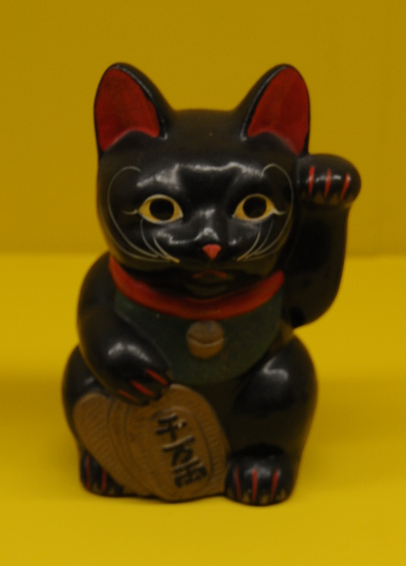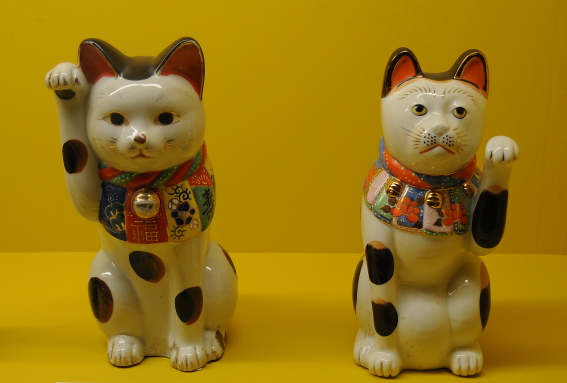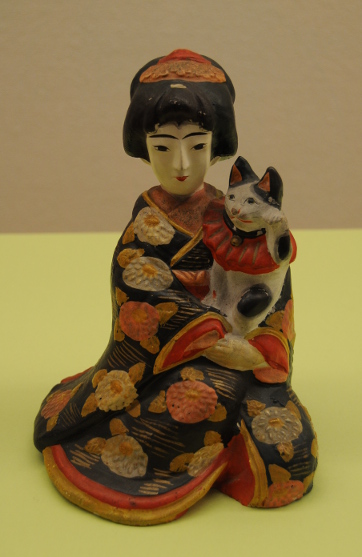The maneki neko – literally beckoning cat, also called welcoming cat, lucky cat etc. – is probably one of the best known objects associated with Japan. The little cat figurine with its raised paw can be found at the entrances or cash registers of most shops and restaurants in Japan, and has made its way into numerous Asian restaurants abroad as well.  The maneki neko is of truly Japanese origin, although when exactly it became customary to put the little statue up is unclear. They most likely first appeared in Tokyo in the mid to late 19th century, and by 1902 they were already extremely popular. There are a number of folk tales that give a story for the first appearance of the maneki neko; the one most down to earth simply talks about two competing ramen shops situated next to each other. One of them put up a maneki neko in the window, just to see an increase in customers, at least until the other shop followed suit.
The maneki neko is of truly Japanese origin, although when exactly it became customary to put the little statue up is unclear. They most likely first appeared in Tokyo in the mid to late 19th century, and by 1902 they were already extremely popular. There are a number of folk tales that give a story for the first appearance of the maneki neko; the one most down to earth simply talks about two competing ramen shops situated next to each other. One of them put up a maneki neko in the window, just to see an increase in customers, at least until the other shop followed suit.
 A cat statue is only allowed to call itself maneki neko if it has a paw raised in the typical Asian beckoning gesture, which is executed palm-down here. The raised paw is supposed to beckon customers and/or wealth in general. You can find maneki neko with left or right paws raised, but interestingly not even the Japanese themselves seem to know whether the right paw stands for money and the left paw for customers or vice versa. Other interpretations are one paw for shops (especially bars), the other paw for the home; one for wealth, the other for luck… About 60% of the Japanese maneki neko have their left paw raised, thus bringing in customers (probably), according to research by the Japanese Maneki Neko Club. Really clever people have come up with maneki neko that raise both paws, just to be sure, but they are not very common.
A cat statue is only allowed to call itself maneki neko if it has a paw raised in the typical Asian beckoning gesture, which is executed palm-down here. The raised paw is supposed to beckon customers and/or wealth in general. You can find maneki neko with left or right paws raised, but interestingly not even the Japanese themselves seem to know whether the right paw stands for money and the left paw for customers or vice versa. Other interpretations are one paw for shops (especially bars), the other paw for the home; one for wealth, the other for luck… About 60% of the Japanese maneki neko have their left paw raised, thus bringing in customers (probably), according to research by the Japanese Maneki Neko Club. Really clever people have come up with maneki neko that raise both paws, just to be sure, but they are not very common.
 In any case, the paw became raised higher and higher over time, so some people use this as an indicator of the age of the statue. The idea is here to increase the reach of the cat to lure in customers and money. The latest development is clearly the solar-powered arm that is beckoning for real – and forever.
In any case, the paw became raised higher and higher over time, so some people use this as an indicator of the age of the statue. The idea is here to increase the reach of the cat to lure in customers and money. The latest development is clearly the solar-powered arm that is beckoning for real – and forever.
Other common features of a maneki neko are the red collar with a bell and a little bib. These things most likely go back to the Edo period where wealthy pet owners were actually dressing their cats like that. Furthermore, many maneki neko hold or sit on coins, mallets, carp, or marbles and gems, all of which symbolise money. The coin represents a koban, a gold coin used in the Edo period that was worth one ryo, and the writing on the coin usually says senmanryo – 10 million ryo – a huge amount of money, not just for a little shop owner.
Maneki neko come in various colours. The three-colored calico is based on the Japanese bobtail breed and, probably because those animals are quite rare, is considered the luckiest. Other traditional colours are white (happiness, purity, and positive energy), black (to ward off evil spirits and, in a modern interpretation: stalkers), and gold (wealth and prosperity). A red color is rather unusual, it stands for protection from evil and illness, but nowadays, maneki neko can be bought in practically any color – with more or less modern meanings attached.
 An interesting side note to the probable origin of the maneki neko is the following: In the Edo period, sex was not quite as shunned as it is today, and many houses where female companions were available had shelves with lucky charms – often in the shape of penises of all sizes. Enter the Meiji restoration and the opening of Japan to the much more prude West; obviously those charms had to go. However, they were replaced with the maneki neko, because in Japan, the cat is associated with young, beautiful women, especially geisha. This may be because of the witchery cats are said to be exercising – just like young women…
An interesting side note to the probable origin of the maneki neko is the following: In the Edo period, sex was not quite as shunned as it is today, and many houses where female companions were available had shelves with lucky charms – often in the shape of penises of all sizes. Enter the Meiji restoration and the opening of Japan to the much more prude West; obviously those charms had to go. However, they were replaced with the maneki neko, because in Japan, the cat is associated with young, beautiful women, especially geisha. This may be because of the witchery cats are said to be exercising – just like young women…
